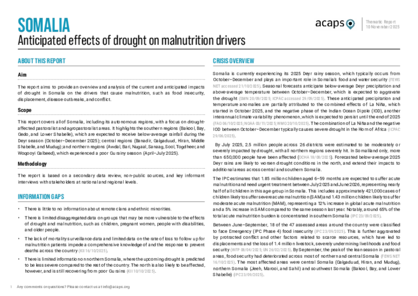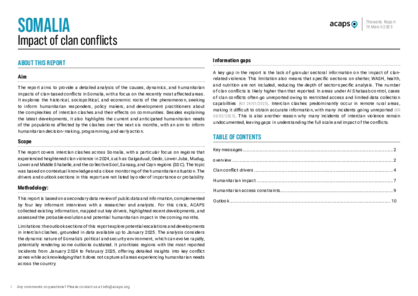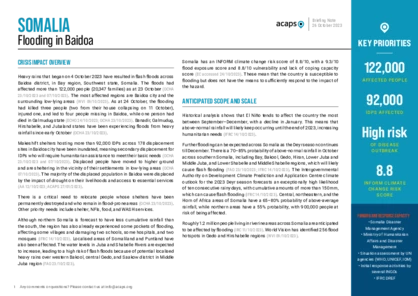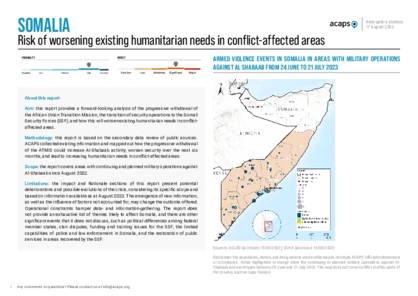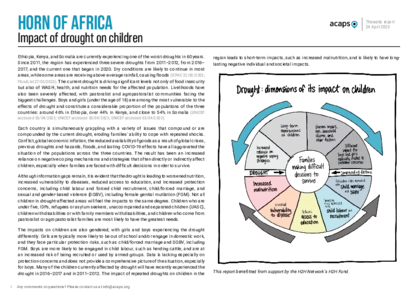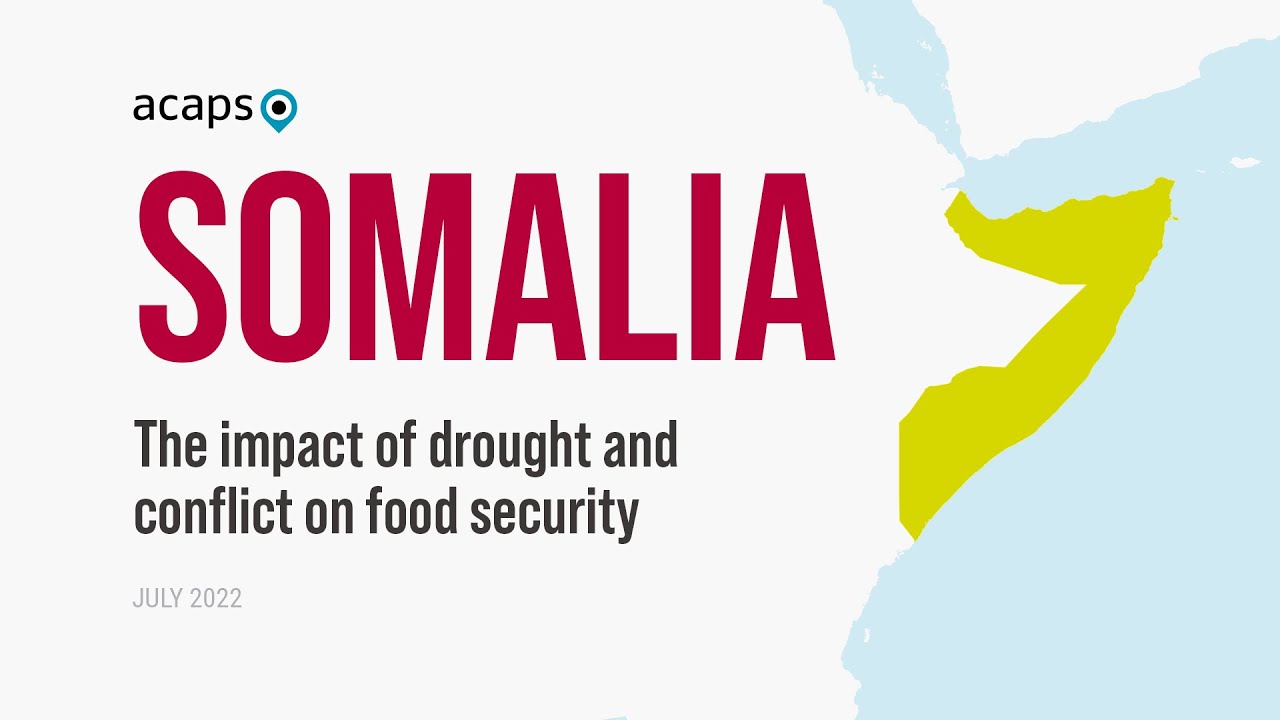Latest updates on country situation
25 November 2025
Severe drought in Somaliland had closed over 150 schools by November 2025, disrupting learning for 45,000 children as families migrate in search of water and pasture. With school feeding suspended and teachers leaving, 260 additional schools also risk closure. Authorities warn that thousands of students may permanently drop out without urgent food and water support. (Hiiraan 24/11/2025, CNN 21/11/2025, Education Cluster 31/10/2025)
18 November 2025
In mid-November 2025, the Somalia Disaster Management Agency declared a national drought emergency driven by the fourth consecutive failed rainy season in some northern, central, and southern regions, which has severely depleted water and rangelands. The crisis triggered the displacement of over 40,000 people in October and occurs as 4.4 million Somalis face acute food insecurity. (ECHO 14/11/2025, OCHA 13/11/2025)
23 September 2025
In northern and eastern Somalia, worsening drought in September is affecting more than 2.5 million people, including 900,000 in the hardest-hit districts. Water shortages and livestock losses are deepening displacement and vulnerability to food insecurity, malnutrition, and disease outbreaks. Over 160,000 people in Puntland state urgently need water support, while limited funding constrains health and nutrition services. (OCHA 21/09/2025, IPC 23/09/2025)
19 August 2025
Drought continues to affect northern Somalia, with an estimated 2.5 million people across 26 districts facing moderate to severe impacts in August 2025. Around 887,000 people are in the hardest-hit areas, particularly in Awdal, Bari, Mudug, Nugaal, Sanaag, and Woqooyi Galbeed regions. Consecutive failed rainy seasons have depleted water sources, dried up pasture, and caused major livestock losses. In July, Awdal region reported extreme temperatures, widespread water shortages, and worsening food security, prompting calls for emergency water trucking, food distributions, and the rehabilitation of non-functional wells. In Mudug, shallow wells have dried up, water prices have nearly doubled, and more than 80 health facilities are no longer operational. Similar challenges are observed in Puntland, where over 134 boreholes are out of service. Authorities in both Puntland and Somaliland have declared drought emergencies and appealed for urgent humanitarian assistance, including food, water, livestock feed, and nutrition support. (OCHA 18/08/2025, OCHA 05/08/2025, WASH Cluster 09/08/2025)
04 August 2025
Conflict in Hiran and Gedo regions has displaced over 100,000 people since June 2025, disrupting essential services. In Hiran alone, 62,000 have fled, with urgent needs reported for shelter, food, water, healthcare, and protection amid continued insecurity and suspended health services. (OCHA 04/08/2025, OCHA 29/07/2025, ECHO 30/07/2025)
14 July 2025
Intensified armed clashes between government forces and non-state armed groups in Moqokori town, Hiran region, have displaced thousands. At least 6,780 people have fled to nearby Buulobarde, Jalalaqsi, and Mahas districts in the same region. Since January 2025, over 58,260 people have been uprooted across Hiran and Middle Shabelle regions. Moqokori town, once a refuge for drought-displaced families, also faces compounding challenges from conflict. Insecurity has suspended operations in six health facilities, cutting off access to critical healthcare services, including maternal care and emergency treatment. Water sources and supply routes are severely disrupted, heightening the risk of disease outbreaks and malnutrition. Humanitarian organisations and local authorities are working to verify displacement figures and assess response options where access allows, as it remains challenging in the conflict-affected districts, with continued violence threatening to further isolate affected communities and disrupt essential services. (OCHA 10/07/2025, ECHO 11/07/2025, GO 07/07/2025)
14 May 2025
By 13 May 2025, flash floods from the Gu rains, which began in mid-April, had affected over 84,000 people across Somalia, with major impacts in Banadir, Galmudug, Hirshabelle, and South West states. The floods have displaced over 8,000 people, destroyed shelters (heavily affecting IDP sites in Banadir and Gaalkacyo), and damaged key infrastructure, including roads, schools, and health facilities. Widespread WASH disruptions and rising health risks are reported, while access to clean water, shelter, and basic services remains critically limited. (OCHA 13/05/2025, The Eastleigh Voice 14/05/2025, ECHO 13/05/2025)
current crises
in
Somalia
These crises have been identified through the INFORM Severity Index, a tool for measuring and comparing the severity of humanitarian crises globally.
SOM001 - Complex crisis
Last updated 27/11/2025
Drivers
Conflict/ Violence
International Displacement
Floods
Drought/drier conditions
Crisis level
Country
Severity level
4.3 Very High
Access constraints
4.0
SOM002 - International displacement
Last updated 27/11/2025
Drivers
International Displacement
Crisis level
Country
Severity level
2 Low
Access constraints
3.0
Active risks
Analysis products
on
Somalia
10 November 2025
Somalia: anticipated effects of drought on malnutrition drivers
DOCUMENT / PDF / 759 KB
The report aims to provide an overview and analysis of the current and anticipated impacts of drought in Somalia on the drivers that cause malnutrition, such as food insecurity, displacement, disease outbreaks, and conflict.
19 March 2025
Somalia: Impact of clan conflicts
DOCUMENT / PDF / 1 MB
This report aims to provide a detailed analysis of the causes, dynamics, and humanitarian impacts of clan-based conflicts in Somalia, with a focus on the recently most affected areas. It explores the historical, sociopolitical, and economic roots of the phenomenon, seeking to inform humanitarian responders, policy makers, and development practitioners.
Attached resources
26 October 2023
Somalia: flooding in Baidoa
DOCUMENT / PDF / 2 MB
Heavy rains that began on 4 October 2023 have resulted in flash floods across Baidoa district, in Bay region, Southwest state, Somalia. The floods had affected more than 122,000 people (20,347 families) as at 23 October. The most affected regions are Baidoa city and the surrounding low-lying areas.
17 August 2023
Somalia: risk of worsening existing humanitarian needs in conflict-affected areas
DOCUMENT / PDF / 518 KB
This report provides a forward-looking analysis of the progressive withdrawal of the African Union Transition Mission, the transition of security operations to the Somali Security Forces (SSF), and how this will worsen existing humanitarian needs in conflictaffected areas.
24 April 2023
Horn of Africa: Impact of drought on children
DOCUMENT / PDF / 5 MB
Ethiopia, Kenya, and Somalia are currently experiencing one of the worst droughts in 60 years. The current drought is driving significant levels not only of food insecurity but also of WASH, health, and nutrition needs for the affected population.


